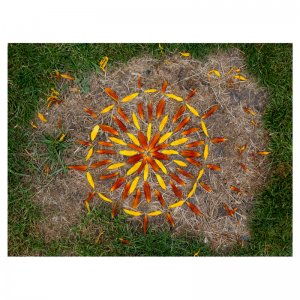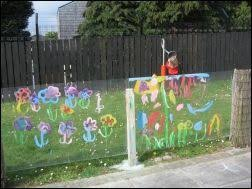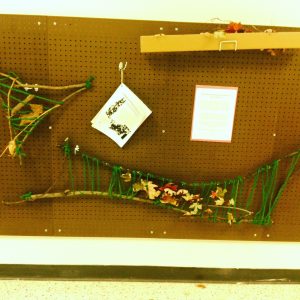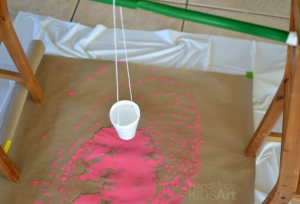Creative Activities Go Outside
In preparation for Summer, Leslie Layman, coordinator of the Truman College Child Development Program, will discuss her favorite ideas for taking Math and and other STEAM ideas outside.

Parents often bring their young children into our professional care because they want better for their child in future. They hope for their child to become more social, better educated, or more prepared for formal schooling. We often see this discussed in terms of which skills we hope children will gain from having been in early education. Most recently, we see reporting on the 21st Century Skills that children will need in upcoming decades to be successful as adults or in the workplace. While I don’t love the idea of thinking of young children in terms of their future employment, I do believe that parents’ desires to know that their children are being supported to develop and grow while in our care is quite valid. No matter which list you look at or what outcomes for children you are hoping to promote, you will almost always see two things: creativity and social skills. I believe that taking creative activities outside and integrating them into playful group interactions is one way to meet those needs. For this last blog in the series, I would like to share some of my favorite ideas for outdoor creative activities.
In my opinion, the three best things about taking creative activities outside are that they can become: Big, Nature Based, and Messy. I’ll share my favorite ideas in these categories.
Big
When you’re outdoors you have so much more space to do big, group projects. One of the simplest things to do is to take your blocks and things that go outside and add some chalk. Children now have the freedom to not only build, but to design a city, a farm, a magical universe around what they are building. All the better if you can leave the chalk and come back to it the next day and let their design grow and grow. Creativity does not always mean working with traditional visual arts like paint; the deep creativity and design thinking that it takes a group of children to plan and build a city is intense and meaningful. This planning and design requires many overlapping early math skills and uses them functionally: spatial relationships, measurements, counting, and much more.
 Another outdoor activity that I love, that requires some planning and construction, but can be done fairly cheaply is to make a large, group plexiglass canvas.
Another outdoor activity that I love, that requires some planning and construction, but can be done fairly cheaply is to make a large, group plexiglass canvas.
Children now must navigate not only the creative experience of imagining something on their own and then expressing it through paint, but they must also interact socially to paint in tandem with other children. Their experience of their creation is quite different as the painting now has two sides and interacts dynamically with changes in light and weather. They can really play with angles, position, and size in way that is not possible on their own piece of paper.
Nature Based

One of my favorite math and creative activities is weaving. It includes fractions, cardinality, spatial relationships and lots more math. It is often a skill that many children come to us already interested in as they have experience with braiding and twisting their hair. It is also quite empowering for children to make a piece of clothing or a toy with their own hands. When I take weaving outside, I like to incorporate natural materials into the weave, using large sticks as the loom. There is something satisfying and soothing about seeing the natural materials as part of the weave. Weaving is also a big and tiring project, so you can lessen the burden by weaving as a group. Children learn to help each other, take turns, and allow others to make choices in these shared weaving activities.
I also love gardening as a math and nature based activity. In many urban communities, schools can get a discount on a shared plot. You can also create rich gardening experiences with buckets, planters, and in reclaimed recycled materials such as barrels, crates, and bathtubs. Children must count and measure where to put the seeds. They must understand the passage of time as they wait for the plants to grow. They build social, caretaking skills as they water, feed, move, and fret over the plants. Caring for plants a group makes you part of a community in which everyone can have a roll, data takers, waters, soil tillers. Even better if they plant things that they can eat to increase their sensory connection to nature.
Messy
My favorite category. I love to do dynamic and mechanical painting. Painting with toy cars and trucks, making machines that paint, creating a painting pendulum, and even painting with squirt guns. So many children are not successful with or do not enjoy creative activities because they feel pressure for their final product to “look right.” Big body movements and wild, messy painting with no end product in mind can be freeing for these children and act as a creative spark that supports them in further creative activities. It also supports the planning and proprioceptive skills they need to be ready for early math concepts and social interactions. Best thing about it? If it gets too messy, get out the hose and then it’s water play time.

My last activity is a favorite and it’s free. Mud! Let kids get messy head to toe. It’s a rich and necessary sensory experience. Children need time to feel different textures, have their shoes off, and not worry about what’s happening to their clothes and hair. We are finding more and more in research that important connections are built in children’s brains during these free, messy, and particularly barefooted activities. If you add dramatic play props; buckets, dolls, trucks/cars, blocks, etc. the children will naturally begin using the mud creatively and socially as part of their natural pretend play. Dumping mud from bucket to bucket also requires measuring and supports thinking that leads to conservation of mass and other important concepts.
I hope throughout this series that I given you some ideas or reminded you of some old favorite ways of using things that we know work for and are important for young children into your professional setting and information to defend the deep math learning that comes with those activities. Children can and will learn math through plan and outdoor experiences when they are given the space, time, and freedom.
Very creative
Very creative. I love your idea of creating mechanical tools for painting.
very creative
So True! My yard is enclosed with a wood fence and the children love making large pictures, cities, etc. on it with chalk. Lots of fun water play when we decide to hose it away to make room for more. We also use the inexpensive sponge brushes and buckets of water and create with those. They love watching it ‘magically’ disappear as the sun dries them away!
Our preschool playground includes a bucket of long, flexible strips of plastic that the children can weave in between the links of the fence around the playground. I’ve watched them do it many times, but not with any understanding of how it supports math learning. Now I have a fresh perspective!
Hi Leslie, as I am preparing for the new Classroom I wanted to add more math to my lesson plans, and I am taking the Math Courses on Gateway and I came across your article!!! I love it, I am going to be doing it in our Fall adventure outside as we reopen our new remodeled day care center!!! I would love to invite you to our grand opening!!! Thank you for such a wonderful article and great idea to expand the math knowledge to our little ones!!! Mrs. M Rivera-Lopez!!!!
Love these ideas, creative, fun, and exciting.
I love these ideas I think that I would use them. I never thought of these ideas.
lovely ideas.
This is very interesting, I would like to try these ideas
We have a music wall and a wooden art wall in our yard. I like how you have kids paint cars and trucks and Im thinking that we could do that on our art wall. I love these ideas it have my mind going.